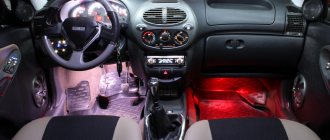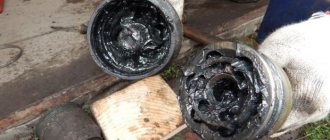(
unofficial name “Ninety-ninth”
[1] [2] [3]) is a Soviet and Russian front-wheel drive car of group II small class with a sedan body. It is the most full-size model in the Lada Sputnik family.
The machine was prepared for assembly line production in March 1990, but the start of production was delayed due to a delay in the supply of components from related enterprises [4]. Serially produced at the AvtoVAZ plant from December 22, 1990 to June 30, 2004. Until the end of 2011, it was assembled in Ukraine using Russian car kits with interior design similar to that of the VAZ-2115. The VAZ-21099 was exported under the names Lada Forma, Lada Sagona, Lada Diva, Lada Sable, Lada Samara Saloon
.
Modifications [edit | edit code]
Since the start of production, modifications with carburetor and injection engines with a working volume of 1.3 liters (VAZ-210993) and 1.5 liters (VAZ-210990) have been produced in different years. The model range of JSC AVTOVAZ includes modifications of the VAZ-21099 with carburetor and injection engines 210992 (VAZ-21099i). A version with permanent all-wheel drive (Lada-Victory) was also produced, but production was discontinued due to low sales. And the model with a turbocharged 8-valve engine (Lada Sport) was produced only by individual order.
In 1997, modification 21099-91 appeared with a VAZ-415 rotary two-section engine [5].
Design differences
What is the difference between 2109 and 21099?
Even though these two cars are very similar, there are still some differences between them.
So, 21099 had the following features:
- A different radiator grille configuration.
- Instrument panel with a tachometer (early versions).
- The rear overhang of the body has been increased by 20 centimeters.
Variations
VAZ 2109 and 21099 had modifications with identical technical characteristics.
Therefore, it is more logical to present only the power units with which these models were equipped:
- The engine is 1.3 liters with an output of 64 horsepower.
- The engine is 1.5 liters, producing 70 horsepower.
- Installation of 1.5 liters with fuel injection system. Develops 78 “horses”.
All engines were equipped with a five-speed manual transmission.
LADA Victory [edit | edit code]
The difference from the base model was that Victory was a four-wheel drive (4x4) vehicle. LADA Victory was created by adding a transmission, in particular an angular gearbox, a viscous coupling of the VAZ 21099 model and a Volkswagen Golf Syncro rear axle gearbox. The axle shafts remained from the base model, one transmits torque from the engine to the rear axle, and two more serve to drive the front wheels. The exterior of the Victory differed from the basic modifications of the VAZ 21099 by a rear spoiler; the car was equipped with alloy, fourteen (14″) inch sports wheels and bright red “Victory” and “4×4” nameplates on the trunk lid.
The exhaust system was also changed on Victory, and the engine was installed with a volume of 1600 cm². Speaking about the technical characteristics of the car, we can note the good acceleration dynamics of the Victory, which is not surprising, because the engine was installed with a boost [7].
All-wheel drive provided the car with simply amazing maneuverability, but due to its cost, the VAZ 21099 Victory was not widely used, and production of the car was curtailed. The car was also exported to countries in Europe, Asia, Africa, North and South America. [ source not specified 151 days
]
Specifications
| Engine | 1.3l, 8-cl. | 1.5l, 8-cl. | 1.5l, 8-cl. |
| Length, mm | 4006 | 4006 | 4006 |
| Width, mm | 1650 | 1620 | 1620 |
| Height, mm | 1402 | 1402 | 1402 |
| Base, mm | 2460 | 2460 | 2460 |
| Front wheel track, mm | 1400 | 1400 | 1400 |
| Rear wheel track, mm | 1370 | 1370 | 1370 |
| Weight in running order, kg | 925 | 925 | 945 |
| Gross vehicle weight, kg | 1350 | 1350 | 1370 |
| Permissible total weight of a towed trailer with brakes, kg | 900 | 900 | 900 |
| Ground clearance, mm | 160 | 160 | 160 |
| Trunk volume min/max, l | 330/640 | 330/640 | 330/640 |
| Wheel formula/drive wheels | 4x2/front | ||
| Car layout diagram | Front-wheel drive, front engine, transverse | ||
| Body type/number of doors | Hatchback/5 | ||
| engine's type | Petrol | ||
| Supply system | Carburetor | Carburetor | Distributed injection |
| Cylinder diameter, mm | 76 | 82 | 82 |
| Piston stroke, mm | 71 | 71 | 71 |
| Compression ratio | 9,9 | 9,9 | 9,9 |
| Engine displacement, cm3 | 1288 | 1499 | 1499 |
| Maximum power, kW/rpm | 64/5600 | 68/5600 | 78/5400 |
| Maximum torque, Nm at rpm | 95 / 3400 | 100 / 3400 | 116 / 3000 |
| Fuel | AI-92 | AI-92 | AI-95 |
| Fuel consumption in the urban cycle, l/100km | — | 8,7 | 9,9 |
| Maximum speed, km/h | 148 | 154 | 155 |
| Acceleration to 100 km/h, s | 16 | 14 | 13 |
| Transmission | With manual control | ||
| Number of gears | 5 forward, 1 reverse | ||
| Steering | Rack type, without amplifier | ||
| Tires | 175/70R13 5Jx13; | ||
| Fuel tank capacity | 43 | 43 | 43 |
year of completion of production of VAZ 21099
2108 – 2003 2109 – 2005
But I could be wrong, because... 2109 was also produced in Syzran, and I don’t know when it was discontinued there.
In Ukraine, VAZs with engines from ZAZ were produced.
And those who live there can give you a better idea about the price here.
Exactly go the other way around
The appearance of the first domestic serial front-wheel drive vehicle is a milestone in the history of the Volzhsky Automobile Plant and the entire Soviet automobile industry. It is symbolic that the start of production of the VAZ-2108 coincided with a significant date celebrated in November 1984, the 60th anniversary of the USSR automobile industry. And two years later, a pilot production batch of 159 VAZ-2109 five-door hatchbacks based on the G8 rolled off the main VAZ assembly line. The new “nine”, which inherited all the technical innovations of its “big sister”, immediately won the recognition of car enthusiasts: its competitive advantage was the “correct” number of doors. And yet, the three-door modification was the first to hit the assembly line. Why? Indeed, in a country where a personal car was considered a luxury, and the transport problems of their relatives and friends fell on the shoulders of the happy owners of their own cars, the classic three-volume sedan best met the needs of the car enthusiast.
For decades, all production passenger cars in the USSR were produced with just such a body. More practical station wagons, produced in small quantities, went on sale only at the end of the 60s and remained in terrible short supply. There was no talk of other body types: the heads of the car factories did not even try to experiment, rightly believing that projects of such cars would not meet with support “at the top.” However, in the case of the “eighth” family, everything turned out exactly the opposite. At the end of the 70s, Europe was swept by the fashion for hatchbacks. And VAZ, trying to keep up with the times, when designing a new model line, included in it, in addition to the traditional sedan, three- and five-door hatchbacks that were completely new to the Soviet industry. The appearance on the foreign market of a new car, created taking into account global trends, was supposed to strengthen VAZ's export position. The Ministry of Automotive Industry cooled down the ardor of Tolyatti engineers somewhat, considering
it is impossible to finance the production of all three models. It was realistic to free up only one thread of the factory conveyor for the assembly of two unified modifications. The “lucky” ones were hatchbacks that had the maximum number of common body parts. The cheaper three-door model was chosen as the base option, and two years later it was joined by a five-door model. The VAZ-21099 sedan was launched into production only at the end of 1990. However, this delay to some extent turned out to be to the benefit of the plant: if the sedan had appeared at the same time as the hatchbacks, it would certainly have competed with them. The rush demand for the VAZ-21099 is further confirmation of this.
Your face
Despite the identical overall dimensions and general style, the “eight” and “nine” turned out to be conceptually different cars. The unusually wide doors and massive central pillar of the VAZ-2108 added to the appearance of the car
"sporty touch" On the VAZ-2109, the width of the front doors was reduced from 1264 to 1025 mm, due to which the designers managed to fit 885 mm wide rear doors into the sidewall of the body. In the design of the “nine” one could still discern the swiftness of the lines, but “sportiness” faded into the background, giving way to practicality. Compared to the G8, the VAZ-2109 became a little heavier from 900 to 915 kg. By the time the VAZ-2109 series was launched, the factory workers had the opportunity to add space for exhaust ventilation deflectors. On the VAZ-2109 of the early years of production, small grilles were located in the lower corner of the fixed side windows. Since 1991, external deflectors were abandoned in order to unify the hatchback with the VAZ-21099 sedan. The side windows of the sedan were smaller, so the ventilation grilles were placed at the ends of the rear doors. The same solution was used on the VAZ-2109, and the abandonment of external grilles made it possible to slightly increase the size of the windows.
Trial
Nothing extra
These two cars look quite attractive. Their design is devoid of provocative solutions, but it is harmonious and thoughtful. “Nine” has a more rapid body profile, while 21099 is more sedate and respectable.
In terms of geometric cross-country ability, the 2109 has a slight advantage due to shorter body overhangs. But driving over potholes on the 21099 is more problematic due to the long stern.
Comfortable and cozy
The interior of both Samaras is identical. It is worth mentioning in advance that the quality of finishing materials is far from ideal - hard, echoing plastic everywhere. Of course, plastic made it possible to reduce the weight of cars, but it deprived VAZ models of that touch of luxury for which the Zhiguli of the classic family is famous. At the same time, the ergonomics are good and you don’t have to be distracted from the road thanks to the compact layout of the controls.
Elastic front seats provide good body support. However, a tall driver will complain about the lack of adjustment of his seat in the longitudinal plane. Only two passengers are comfortable on the back seat, provided their height is less than 175 centimeters.
As for the luggage compartment, there are differences between 2109 and 21099. The “Nine” has a trunk volume of 270 liters, while its more practical companion platform has this figure already equal to 400 liters.
FINPLAN
The price range is from 30,000 rubles for outright rubbish to 250,000 for cars of the last years of production in the original and without any hint of tuning. By the way, about fine-tuning: it was the first wave of domestic front-wheel drive that Russia owed to the flourishing production of all kinds of automotive accessories of varying degrees of usefulness. That is why such cars are now readily bought in order to turn them into sports cars.
Another secret of its popularity is the availability of spare parts, which allows you to restore an extremely shabby car for a very modest price (even compared to other state-owned vehicles). Judge for yourself: the outer side panel is 2,200 rubles, a similar part for the Nexia is 10,860. The hood for the 99th is 1,980 rubles, the owners of the Daewoo will have to shell out 8,400. Surprisingly, very large pieces of hardware often cost significantly less than you pay for their subsequent coloring. What a carburetor, buy a new assembled carburetor engine for a VAZ-21099 for 35,400 rubles!
What is the reason for floating revolutions
Car owners often continue to operate their vehicle even if the engine is unstable while driving. However, such a malfunction can have a number of negative consequences. Firstly, floating speeds can easily lead to a traffic accident when, when coasting or changing gears, the engine stops working and the steering wheel jams. In addition, the driver must be constantly distracted in order to stabilize the speed by stepping on the gas or simply not allowing the engine to stall by keeping his foot on the gas. Secondly, fuel consumption increases significantly, and all engine operation systems operate in variable mode, which creates additional load on them. The malfunction is easily diagnosed, its elimination does not require significant investment of time and money.
Check the spark plugs first
If the coordinated operation of individual components of the power and ignition system is disrupted, various malfunctions occur that lead to engine failures. One of the first signs of a problem is high engine speeds if the injector stalls while driving. The most typical manifestation of a possible malfunction is a situation where the idle speed fluctuates. The speed can change from 500 to 2500-3000 per minute with an oscillation interval of about 1 second. In this case, the number of revolutions is periodically equalized. If the amplitude is larger, the engine will most likely stall.
Situations arise when the control unit receives incorrect information, which is why the electronics cannot make a timely decision about the command being given. If an excess amount of air enters, while the engine temperature is sufficient for normal operation, and the throttle is open in the desired mode, the control unit may not cope with the problem. When engine speeds fluctuate or are simply high, one of the possible reasons may be improper operation of the forced speed increase device. This will be the culprit for the intake of too much air.
A faulty idle speed sensor may also be responsible for floating rpm. This device ensures stable engine operation at any speed. If the sensor does not transmit the correct signal, the volume of air supplied to the cylinder will differ from the required one. In this regard, floating speed is possible not only after starting the engine, but also after it warms up.
Question:
Hello, dear Car Owners and Auto Mechanics. I have a problem of this nature in general terms; I bought a VAZ-21099 injector car. When I purchased the car, it was in working order, but the temperature sensor did not show and the CHECK light was on. The rest is normal. After 3 day trips to register and fill the tank with 95 and a flushing additive, the car stopped starting for 1 day. So after I looked under the hood and saw that the fastening bolt had come off the RXX, I replaced the RXX (idle air control) with a known working one and replaced the mounting bolt. She was standing in the cold, starting it up, it starts very poorly, and then with the gas pedal pressed to the floor and does not pick up speed, it holds somewhere around 500/600, and the CHECK does not light up after waiting for 40-50 seconds with the gas pedal pressed, it picks up speed, I release the pedal, it holds idle speed. I warmed up the car for about 10 minutes, then turned it off and walked away for about 5 minutes and came back again and it won’t start, even with the pedal pressed. It was decided to replace the fuel pump mesh, cut a hole, released the pressure, removed the pump and replaced the mesh with a new one, the old one was very clogged. Changed the fuel filter to no avail. Effect 0. Well, off to a tangent, I replaced (mass air flow sensor), also replaced the throttle assembly and its sensors, replaced the thermostat and temperature gauge sensor, oil pressure sensor, crankshaft position sensor, cleaned the injectors and ramp. Replaced all relays and fuses under the passenger shelf and under the hood. Replaced the spark plugs, (Everything that was changed is known to work) Tensioned the alternator belt. And this is the problem: now the car starts and after 5-20 seconds the pump stalls, pumps, The pressure in the rail after pumping up the fuel pump is 2.3, 2.2 There is a spark on all the spark plugs (the signal is fine) The exhaust is normal The marks match and where the timing belt is and where the flywheel is, The injectors are clean. What I don’t know, I don’t want to go to the service. I decided to climb and in the salon I opened the panel where the brains are (Bosch), for me there is a dark forest coming from the brains, a flagellum with contacts (Not under the shelf), apparently for adjustments there are closed 1st row 2nd contact with 2nd row 3rd contact. I didn’t understand why. I removed the jumper to no effect. I put it back. Tell me, maybe I forgot to check?
Basic faults
Differing from its predecessors only in body type, the VAZ 21099 inherited the malfunctions characteristic of them. However, there are also “original” damages. The most common malfunction of the VAZ 21099 car is unstable idle speed.
Periodically they begin to swim, but it is almost impossible to find any pattern. The cause of this may be the throttle position sensor. It is an ordinary potentiometer, which periodically loses contact due to constant use. Replacing the sensor will help solve the problem.
A faulty ignition module is a common problem for many owners. In this case, the machine operates unstably when driving at low speeds. It’s easier to say - it twitches. Typically this means that there is no contact within the module itself between the coil and the commutator.
Sometimes the car stops starting. The culprit may be the idle speed sensor. You can check this very simply. When starting, you need to press the gas pedal; if the engine starts, the sensor is at fault. The air flow sensor can sometimes cause a rough idle. However, do not rush and run to the store for a new one.
The fact is that, due to its design features, the sensor needs very good contact with the body. It is necessary to check whether there is mass on it. A common problem with Euro 2 engines is exhaust manifold gasket burnout. In this case, “Check-Engine” lights up on the panel.
Hello from the Soviet past: a piece of paper indicating the body color is pasted on the trunk lid.
Hello from the Soviet past: a piece of paper indicating the body color is pasted on the trunk lid. Hello from the Soviet past: a piece of paper indicating the body color is pasted on the trunk lid.
In general, the car was more pleasing than disappointing. I roared the muffler moderately, the CV joints did not crunch when turning. I got the impression that the previous two owners treated it with great love and the mileage of more than 97,000 km is honest. Considering that the car is supposed to run about 150,000 km before its first capital, this one will still serve. So if you find a similar option, you can safely buy it for everyday trips.
In everyday life, the 99 is unpretentious, its appetite is modest, and the horsepower tax is simply ridiculous. The driving qualities are also excellent, it’s not for nothing that the German company took part in the development of the first front-wheel drive family of VAZs. If you are over forty, this car is perfect for relieving mild nostalgia. If you are young, then, owning such a device, you will understand why the 99th for your parents personified the concept of “life is good.” Sophisticated smartphones or tablets are valued in much the same way today in society.
By the way, this car also has a computer. It is, of course, non-standard, but nevertheless shows all the necessary parameters. We never even dreamed of this at the time.











